Reserve Bank of Australia Annual Report – 1990 Financial Markets and the Bank's Operations
Overview
Financial conditions were tight throughout 1989/90 and there was generally less variability in market rates than in other recent years. Financial institutions continued the process of reorganising their activities in response to changing economic circumstances. These developments occurred against a background of slowing domestic activity (and falling asset prices), and rises in overseas interest rates. The latter, taken together with a fall in domestic interest rates, significantly narrowed the extent to which interest rates favoured Australian dollar assets; the Australian dollar nevertheless appreciated over the year.
Internationally, there were signs of a substantial increase in the demand for funds, especially in Europe. This development, together with expectations of higher inflation in Japan and the US, put upward pressures on world interest rates, and bond yields rose in the major countries.
In Australia, interest rates were generally steady in the first half of 1989/90 but declined in the second half with the easing of monetary policy. Overall, there was less volatility in rates than in the past few years. Growth of credit provided by intermediaries slowed markedly as demand for funds dried up and intermediaries adopted a more cautious approach to lending.
18 Interest rates and exchange rates
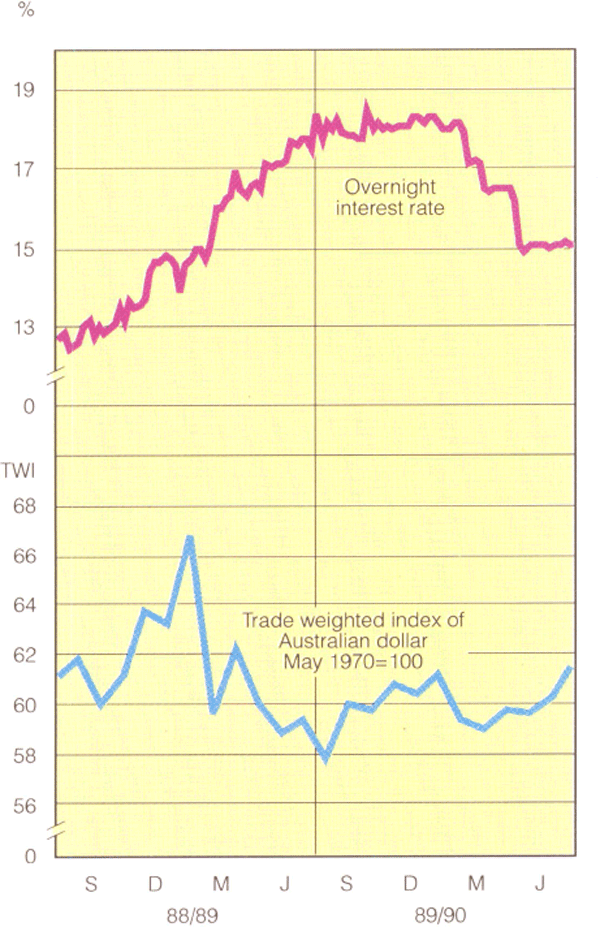
19 Overseas bond yields*
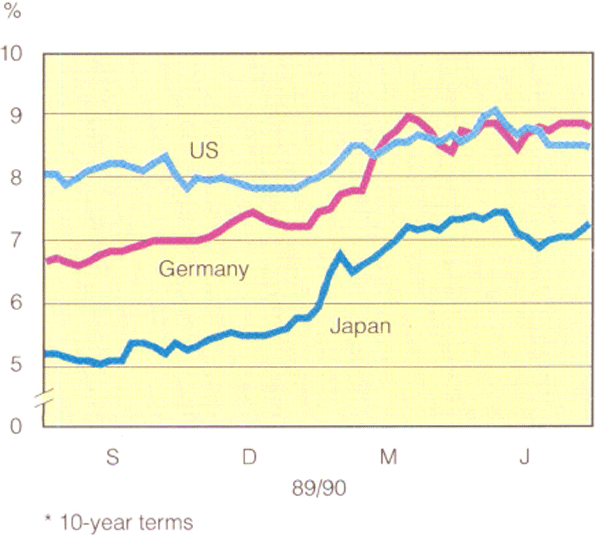
Demand for the Australian dollar was generally strong in 1989/90. Although interest rate differentials narrowed substantially during the year, investors continued to find Australian rates attractive, particularly as they appeared to be convinced that a sizeable differential was likely to be maintained for some time ahead. This factor tended to outweigh the decline in commodity prices over the second half of the year. The average size of fluctuations in the Australian dollar was the lowest in any year since the currency was floated in 1983 and smaller than for the major currencies.
After several years of very rapid expansion, turnover in domestic financial markets generally grew more slowly in 1989/90. In the equities market, where turnover had fallen sharply after the October 1987 crash, there was increased pressure on brokers to reduce the scale of their operations. This led to marked reductions in the number of firms and the level of employment in the industry.
Financial markets generally absorbed the pressures from the slowdown in the domestic economy, including the falls in asset prices. Some financial institutions did, however, face serious stresses. By international standards most parts of Australian financial markets continued to operate with a high degree of efficiency and depth.
The Bank's Operations
The Bank implements monetary policy mainly through transactions in domestic securities markets. It also conducts transactions in foreign exchange, both in Australia and other markets, on behalf of its customers (primarily the Commonwealth Government) and on its own account, to test the strength of market pressures and to influence the actions of participants in the interests of a smoother, more rational market.
In the first half of 1989/90, the Bank's transactions in domestic markets were directed at maintaining the very firm setting of financial conditions established during the previous financial year. Interest rates on overnight and call funds in money markets were broadly unchanged over this period, although security yields declined a little towards the end of 1989. Some intermediaries' interest rates continued to rise, as a lagged response to increases in short-term security yields in the latter part of 1988/89. An exception was major banks' interest rates for housing loans to owner-occupiers. The banks maintained these rates at the 17 per cent level set late in the previous financial year.
Changes to the arrangements under which banks are required to hold Non-callable Deposits with the Bank were announced in September 1989. These changes removed the additional penalty on banks occasioned by the rise in market interest rates during 1988 and 1989; the new arrangements restored a smaller margin (fixed at 5 percentage points) between market rates and the rate on Non-callable Deposits, thereby reducing the cost of funds to banks. This in turn enabled the banks to avoid a further rise in housing loan rates at a time when it was already clear that the housing industry was slowing down.
Generally firm demand for the Australian dollar in the first half of 1989/90 saw the currency appreciate a little. There were some episodes of weakness in the exchange rate but these were short-lived. The Bank's foreign exchange market operations were confined largely to buying foreign exchange to meet the needs of its customers, including for the repayment of foreign currency borrowings by the Commonwealth Government.
During January, with the economic indicators pointed more clearly to a slowing in demand, the Bank put in place a modest first step in easing monetary policy. Further steps were taken in February and April as evidence of the extent of the slowdown accumulated. Each of these adjustments was accomplished quickly and was accompanied by statements from the authorities indicating the context of, and reasons for, the changes.
20 Short-term interest rates
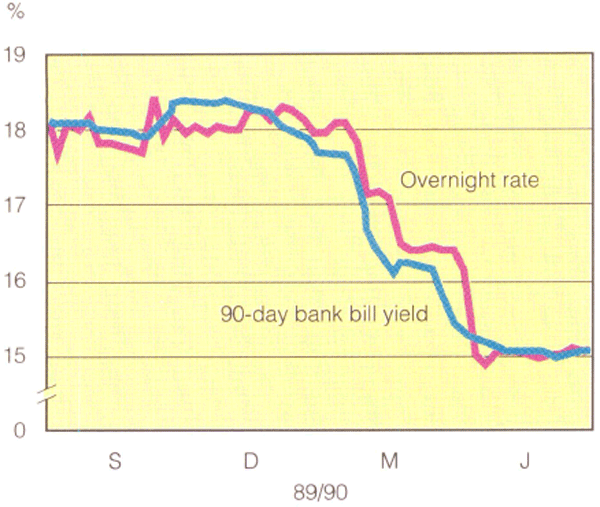
These statements helped to reduce uncertainty in domestic money and foreign exchange markets about monetary policy intentions; they also helped to limit volatility in these markets.
In response to the easings of monetary policy, rates on overnight and call funds fell by about 3 percentage points between January and April. Short-term security yields, which began to decline before January in anticipation of easier monetary conditions, fell by about the same amount. Intermediaries reduced their rates over this period but by lesser amounts. Short-term interest rates and yields remained steady between April and the end of the financial year.
Yields on longer-term securities rose in the second half of 1989/90. These yields are influenced by many factors other than the Bank's domestic market transactions, including changes in bond yields overseas and in expectations about domestic inflation. Increases in bond yields in West Germany, Japan and the US were major factors pushing up domestic long-term bond yields. A further influence was the lowering of the Prime Assets Requirement for banks; this reduced banks' demand for Commonwealth Government securities by about one-third, adding to the tendency for long-term bond yields to rise.
With short-term security yields falling and long-term bond yields rising, the yield curve flattened in the second half of 1989/90, although it remained inverse (i.e. short yields higher than longer yields).
21 Bond yields*
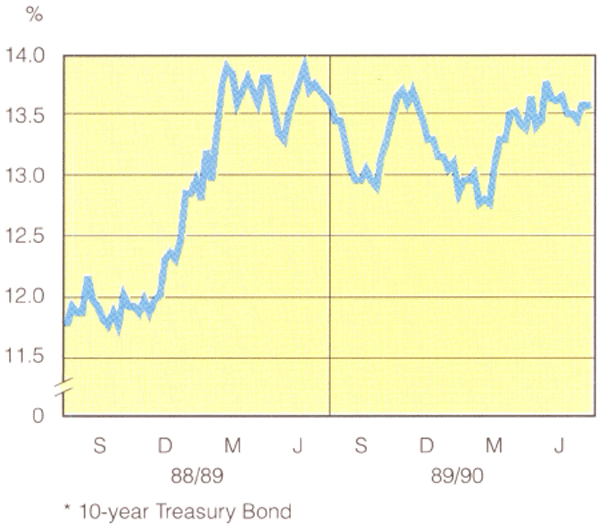
The Australian dollar fell in the days immediately after the January easing in monetary policy but soon recovered, underpinned by still favourable interest differentials and official statements that monetary and other policies would continue to be directed at achieving improvements in inflation and the current account. For much the same reasons, the dollar's decline after the February easing was again very short-lived while there was even a small rise in response to the April easing. Towards the end of 1989/90, strong demand for high-yield currencies boosted the Australian dollar, despite softening commodity prices.
22 Foreign exchange market
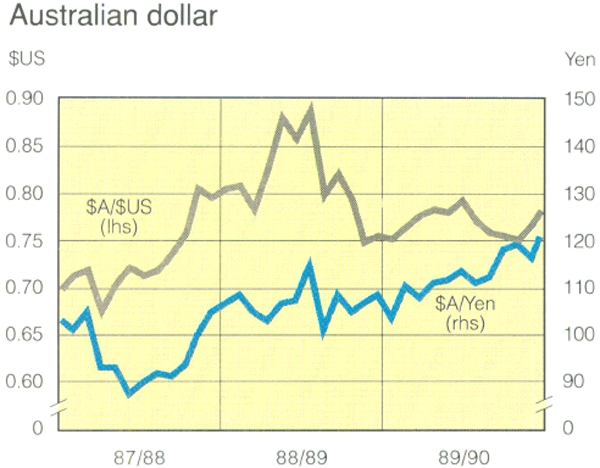
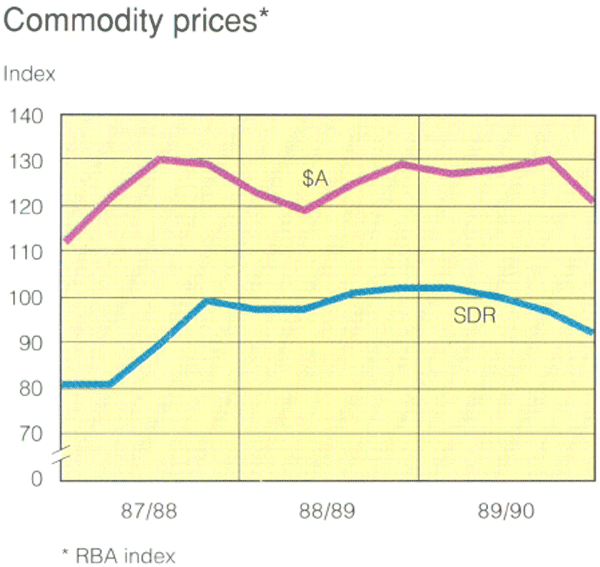
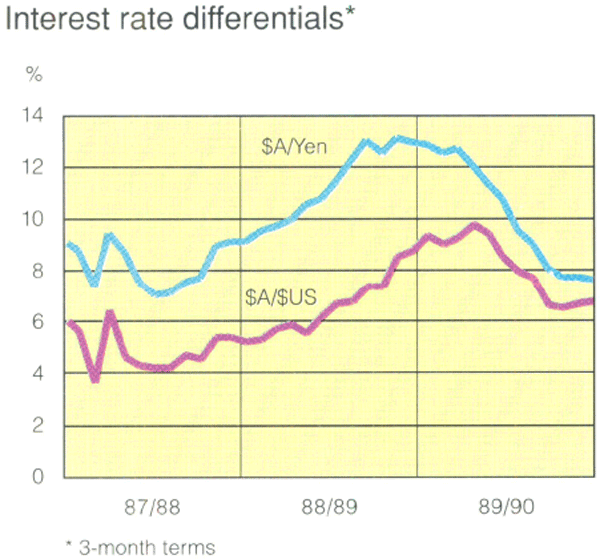
Over the year as a whole, the Australian dollar rose by around 3½ per cent in trade-weighted terms and by 4½ per cent against the US dollar. The Bank's transactions in the foreign exchange market resulted in net purchases of foreign currency equivalent to $6 billion, about $1 billion more than its sales directly to customers; this outcome largely reflected the testing of upward pressures on the exchange rate over the latter months of the year.
Financing
Growth in intermediaries' credit slowed substantially in 1989/90, from an annual rate of about 20 per cent in the June quarter of 1989 to about 9 per cent in the June quarter of 1990. All major categories of lending — housing, other personal, and business — slowed through the year. Growth of intermediaries' deposits and other financial liabilities also slowed markedly, more or less in line with credit.
High interest rates were a factor in the sharp reduction in the demand for credit, in part by raising the cost of funds but also by causing potential borrowers to reassess likely returns from the uses to which funds could be put. Falls in asset prices reinforced the slowing in credit growth, particularly by reducing the amount of loan applications. On the other hand, tightening of supplier credit caused a number of businesses to rely more on intermediaries for funds; overdraft usage tended to rise. Nonetheless, credit demand fell substantially overall.
23 Intermediaries' credit by sector*
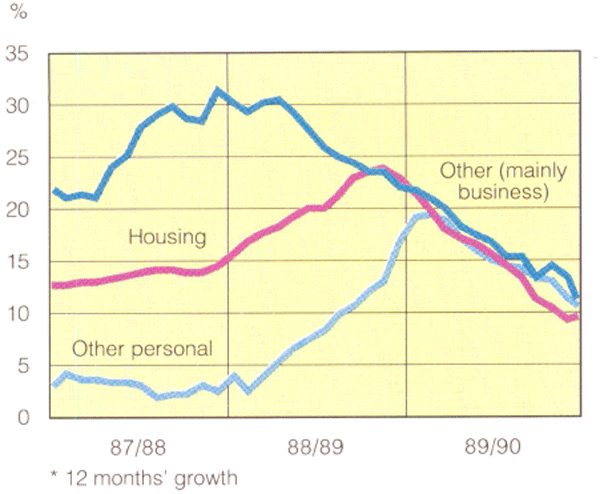
On the supply side, intermediaries' attitudes to lending underwent some changes. Faced with a sharp deterioration in the quality of many loans they increased specific provisions for bad and doubtful debts (to about double previous levels) and tightened their credit assessment procedures. Lending managers became more wary of making bad loans. Intermediaries also sought wider margins between their deposit and lending interest rates to offset the increase in the proportion of loans which were non-performing (i.e. on which no interest was being earned). These margins had been trimmed over the preceding several years by increased competition associated with financial deregulation, including the entry of new banks and the trend for a greater share of deposits to carry market rates of interest. Margins at the end of the year were higher than six months earlier although generally lower than historical levels.
24 Bank lending interest rates
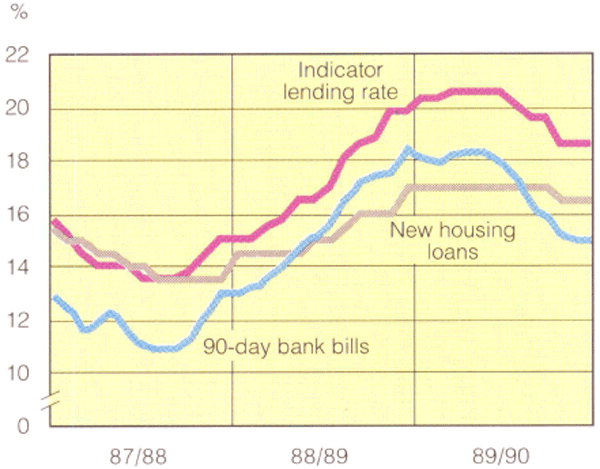
A feature of the housing finance market last year was increased use of fixed-interest rate housing loans. These loans were generally for five-year terms and, with short-term interest rates higher than on medium-term funds, they could be provided at interest rates significantly below those applicable at the time to variable-rate loans. Fixed-rate loans were attractive to borrowers who sought to lock in the lower rate rather than take a chance on the future path of interest rates. Lenders were willing to provide such loans where they could raise fixed-interest rate funds for similar terms or where they could hedge, through interest rate swaps and other transactions, risks of losses if interest rates were to rise during the term. Strong demand for these loans in early 1990 quickly drained the availability of lower-cost longer-term funds, and forced lenders to raise the interest rates applicable to them. This was reinforced by the general rise of longer-term interest rates at the time. When interest rates on the fixed-rate loans rose, and those on variable-rate loans fell, the popularity of the fixed-rate loans dropped sharply.
25 Housing finance approvals (seasonally adjusted)
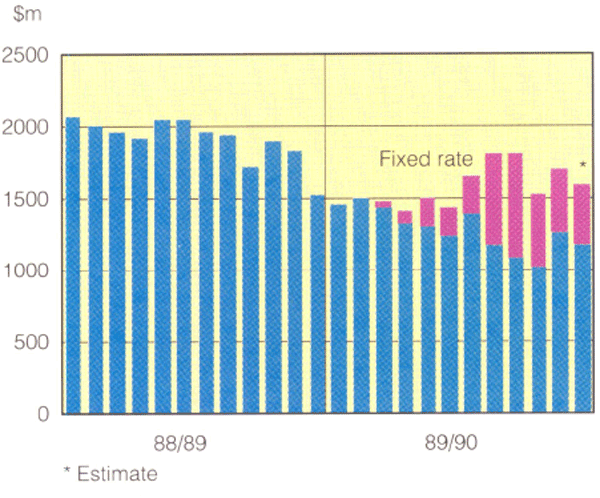
26 Share prices and capital raisings
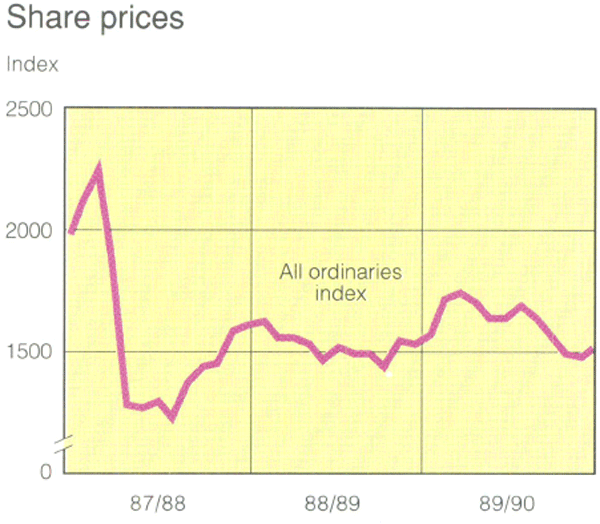
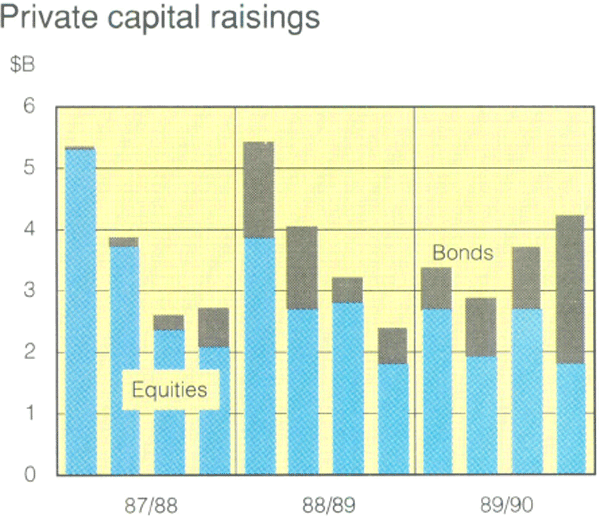
Issues of private medium-term securities, sometimes referred to as “corporate bonds”, rose strongly in 1989/90 as borrowers took advantage of opportunities created by reduced issues of Commonwealth Government bonds. Banks were major issuers as they sought to lengthen the average maturity of their liabilities and, in some cases, to fund the rise in their fixed-rate housing lending. Some of the securities were issued in the retail market while others were marketed wholesale; maturities varied but the majority had maturities of three to five years.
Issues of mortgage-backed securities were also substantial. Despite a boost towards the end of the year, Australian borrowers' use of euromarkets declined in 1989/90, with fewer new issues of securities and substantial maturities of paper issued in the mid 1980s.
Financing through equities was again subdued, a trend evident since the share market crash in October 1987. New equity raisings were lower than a year earlier and secondary share market activity remained quiet.
Foreign Exchange Market
Foreign exchange turnover against the Australian dollar rose over 1989/90, although trading was sluggish in the first half of the year when exchange rate volatility was low. Turnover in “third currencies” — that is, transactions not involving the Australian dollar — grew strongly, notwithstanding increased competition from markets in other Asian centres. A recent global survey of foreign exchange turnover suggested that the Australian dollar was the sixth most actively traded currency and that the Australian market, as a whole, was the eighth largest in the world.
Strong competitive pressures, exacerbated by slower growth in Australian dollar trading and the high costs of maintaining a dealing business, have led to some changes in the structure of the foreign exchange market. Several authorised foreign exchange dealers ceased to make prices in certain currencies and instruments, some non-bank dealers were merged into their domestic bank parents, while others withdrew from the market altogether. The number of authorised foreign exchange dealers fell from a peak of 92 in February 1989 to 81 in June 1990.
The Bank is responsible for authorisation of foreign exchange dealers. It oversees dealers' activities in the market and consults with them on the management of their foreign exchange positions. During the year, the Bank reduced its statistical demands on dealers. The Foreign Exchange Market Consultative Group, which the Bank chairs, is an important forum for discussion of market developments and issues with members of both the dealing and broking communities. One issue for the Group during the year was settlement of pricing differences between dealers and brokers.
At the end of the year, the Treasurer announced the removal of tax screening and certain other requirements in respect of foreign exchange transactions. These requirements were left in place when most exchange controls were removed in late 1983 and early 1984. The introduction of a comprehensive range of tax measures obviated the need for these tax screening requirements.
Commonwealth Government Securities Market
The Bank's domestic market transactions are conducted in Commonwealth government securities, either as outright purchases and sales, or under repurchase agreements. A repurchase agreement involves the sale of securities with a firm commitment to repurchase an equivalent quantity of securities of the same maturity on a future date. Conceptually the Bank could conduct its market operations in a variety of assets, but Commonwealth Government securities are the most appropriate for several reasons: the market has traditionally been deep and liquid; and the securities are homogeneous and carry no credit risk.
The market for Commonwealth Government securities is changing as the Commonwealth Government uses its budget surpluses to reduce debt. In 1989/90, the supply of domestic Commonwealth Government securities (excluding holdings by the Loan Consolidation and Investment Reserve of the Commonwealth — see page 28) fell by $6 billion or 13 per cent, following a fall of $2½ billion the previous year. Much of the fall has been in Treasury bonds, contributing to some reduction in trading volumes in these securities. That has not reduced the effectiveness of the Bank's domestic operations. Most of its transactions are in Treasury notes or repurchase agreements, the market for which has continued to expand, despite some fall in Treasury notes on issue. The Bank's operations still account for only a small part (about 5 per cent) of the total turnover in the Commonwealth Government securities market.
The reduction in banks' Prime Assets Requirement (PAR) (see next chapter) had the effect of making a higher proportion of Commonwealth Government securities on issue available to the market for trading. Market considerations were relevant in deciding the timing of the PAR reduction, which was made in two steps in March and May 1990. The proportion of Commonwealth Government securities held by banks in June 1990 was 40 per cent compared with 45 per cent a year earlier.
27 Commonwealth Government securities on issue*
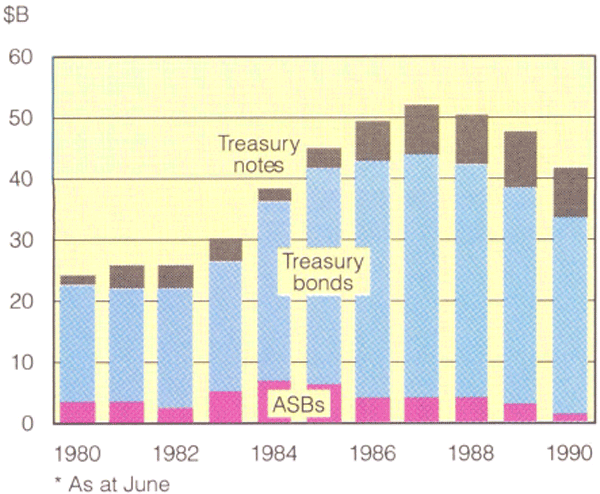
The Bank acts as agent for the Commonwealth Government in the issue of securities. Only one bond tender was held in 1989/90; $400 million was issued to the public and $400 million was subscribed by the Bank. The Government, through the Loan Consolidation and Investment Reserve, also made available to the Bank new securities in exchange for less liquid stocks which the Bank had acquired from the market in the course of its operations with Reporting Bond Dealers. This exercise was aimed at improving the structure of the debt on issue, by replacing less liquid securities with those more keenly sought by the market.
The Bank also conducted a reverse bond tender during the year on behalf of the Commonwealth Government. The tender involved an offer by the Government to buy specified securities; holders were invited to state the price at which they would be willing to sell. In total, $160 million of selected stocks were purchased. The reverse tender gave access to private holdings beyond those normally available in the market; the Commonwealth is giving consideration to holding further reverse tenders in 1990/91.
With the supply of Treasury bonds falling, and limited new issues, turnover in the bond market declined; it averaged $1 billion per day in June 1990, compared with $1½ billion per day in June 1989. Turnover in the major local and semi-government stocks rose strongly.
The volume of Australian Savings Bonds on issue fell sharply in 1989/90. No new issues of these securities have been made since 1987 and three series, amounting in total to $1½ billion, matured during the year. At the end of June 1990 the amount of Australian Savings Bonds on issue totalled less than $1 billion, compared with $7½ billion at the peak of these securities' popularity in early 1984.
The stock of Treasury notes also fell, from $9½ billion to $8¼ billion. The seasonal peak in supply (of $17½ billion) was, however, higher than in any previous year. Turnover in Treasury notes rose in 1989/90, along with turnover in repurchase agreements in Commonwealth Government securities (including both Treasury notes and Treasury bonds). These instruments now account for the major part of trading in the Commonwealth Government securities market.
Changes to Arrangements with Authorised Money Market Dealers
The Reserve Bank conducts the bulk of its money market operations with authorised dealers in the short-term money market. In line with the practice of many other central banks, the Bank believes there are advantages in conducting its operations with a specialist group of market makers.
Arrangements for authorised dealers were reviewed during the year, with the aim of reducing unnecessary controls, increasing the strength and capacity of the authorised dealers, and allowing greater competition.
Ownership guidelines for dealers were amended to remove the requirement for a spread of ownership and the restriction on foreign ownership. However, the restriction on ownership of authorised dealers by banks — and entities with substantial equity in banks — was retained. The Bank believes that the highly-concentrated banking system in Australia makes it important to maintain separation between banks and authorised dealers to create an environment in which the effects of the Bank's market operations can flow widely and freely through the market.
Portfolio restrictions on the authorised dealers were also relaxed. The Bank increased the limit on authorised dealers' holdings of assets other than Commonwealth Government securities, from 30 per cent to 50 per cent of their gearing limits, and allowed dealers to undertake a wider range of transactions in futures and options markets. Following this review of arrangements, the Bank received some expressions of interest from firms wishing to gain authorised status. Two new authorisations have been announced, namely Rothschild Australia Discount Limited and Schroders Australia Discount Limited; this brings the number of authorised dealers to 10.
Clearing and Settlement Systems
Efficient clearing and settlement systems are essential to the smooth functioning of financial markets. The Report of the Group of Thirty on Clearance and Settlement Systems in the World's Securities Markets, released in March 1989, recommended a set of standards for such systems which have been accepted by most countries as desirable goals.
The Bank's interest in clearing and settlement arrangements stems from its general responsibilities for the oversight of payments arrangements in Australia. The Bank fully supports the recommendations of the Group of Thirty and has helped to give wide circulation to the Report within Australia. Some markets in Australia already broadly meet the Group of Thirty standards, including those for bank bills and certificates of deposit, promissory notes, and local and semi-government securities. Over the past year the Bank has continued working to develop an electronic settlement system for the market in Commonwealth Government securities (see page 45).
In Australia's equity markets, however, clearing and settlement systems fall well short, in a number of respects, of the Group of Thirty standards, as well as actual standards in many countries. A Steering Committee, chaired by the Deputy Chairman of the National Companies and Securities Commission, has been established to oversee development of a new system to raise the level of performance in these areas in Australia; the Reserve Bank is actively involved in the Steering Committee.
Movements in the Bank's Portfolio
The Bank's portfolio of domestic and foreign securities (including gold) totalled $23½ billion at the end of June 1990, little changed from a year earlier. Holdings of gold and foreign exchange rose by almost $1½ billion to $21½ billion, while the Bank's holdings of Commonwealth Government securities fell by $1¼ billion.
The factors leading to the rise in the Bank's foreign exchange portfolio are dealt with in the chapter on the Bank's Accounts.
28 Reserve Bank portfolio
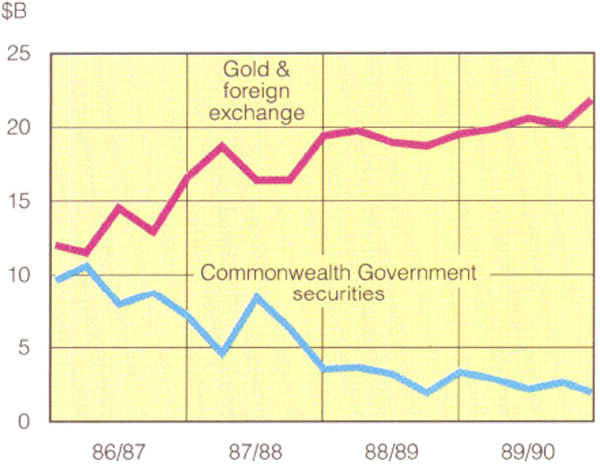
“… I suggest we should receive with grave scepticism pronouncements which suggest that we do not need to worry about prices. A persistent tendency for prices to rise may, like the housemaid's baby, be very small at first — but once people get used to it being around, they may well be astonished at how rapidly it will grow.”
H.C. Coombs
A Matter of Prices, 1959